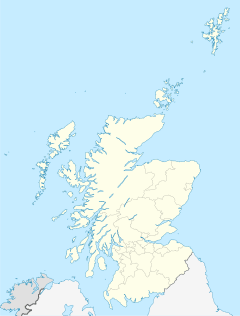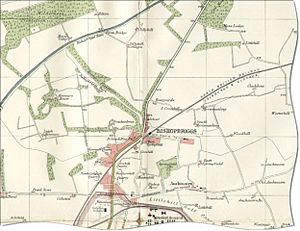Bishopbriggs facts for kids
Quick facts for kids Bishopbriggs
|
|
|---|---|
| Town | |
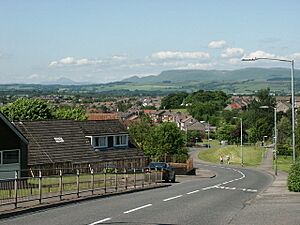 Bishopbriggs Vista, Woodhill Road |
|
| Population | 23,680 (2020) |
| OS grid reference | NS615705 |
| Lieutenancy area | |
| Country | Scotland |
| Sovereign state | United Kingdom |
| Post town | GLASGOW |
| Postcode district | G64 |
| Dialling code | 0141 |
| Ambulance | Scottish |
| EU Parliament | Scotland |
| UK Parliament |
|
| Scottish Parliament |
|
Bishopbriggs (called The Briggs in Scots and Achadh an Easbaig in Scottish Gaelic) is a town in East Dunbartonshire, Scotland. It's located just north of Greater Glasgow, about 4 kilometres (2.5 miles) from the city centre. Long ago, it was part of Lanarkshire county. The area was first given to the Bishop of Glasgow in 1180 by King William the Lion.
Bishopbriggs started as a small village in the 1800s. It grew over time, joining with nearby villages like Auchinairn and Cadder. Today, it's home to about 23,500 people. Because it's so close to Glasgow, many people who live in Bishopbriggs travel to Glasgow for work or school. In 2015 and 2016, a study found Bishopbriggs to be the second most desirable place to live in Scotland!
Contents
History of Bishopbriggs
The history of Bishopbriggs goes back a long way, even to Roman times. The area of Cadder was once a Roman fort on the Antonine Wall. This wall was the furthest northern border of the Roman Empire.
People first wrote about a path to 'Bischopis Briggis' in 1568. The name Bishopbriggs appeared in records in 1655. In the mid-1700s, only eleven people lived there. Even a century later, it was still seen as part of the larger settlement of Cadder. While Glasgow grew quickly, Bishopbriggs managed to keep its own identity. However, some land from the wider Cadder area became part of Glasgow in 1926.
How Bishopbriggs Grew in the 1800s
In 1790, the Forth and Clyde Canal was finished. This canal helped bring ironstone and coal mining to the area. The Carron Company became a big employer. They even built villages like Mavis Valley for their workers. The canal was a great way to transport goods to their ironworks near Falkirk. There were also quarries that dug out freestone, a type of sandstone.
Bishopbriggs grew slowly compared to other industrial areas nearby. In 1836, Bishopbriggs had 175 people, while Auchinairn had 284. The Bishopbriggs railway station opened in 1842. This showed that Bishopbriggs was becoming more important. By 1871, the population of Bishopbriggs was 782.
The area was important for quarrying sandstone. This blonde sandstone was used in many big buildings in Glasgow, like the University of Glasgow. When it became too hard to dig the stone from the surface, miners used underground tunnels. Quarrying stopped in 1907 after a serious accident.
Bishopbriggs in the 1900s
In 1903, the Glasgow tramway system reached Bishopbriggs. Trams helped people travel easily. However, the tram service stopped across Glasgow in 1962.
After the First World War, more factories came to Bishopbriggs. These included a company that made baby food, engineering firms, and the Scottish Wire Rope Company. Blackie and Sons Publishers also opened a large printing works in 1929. During the Second World War, Blackie & Son Ltd even made shells for the army.
In 1932, Bishopbriggs got its first cinema, The Kenmure. It could hold 1000 people! But it closed in 1958 because more people had televisions. The cinema building was later taken down to make way for a shopping centre.
During the Second World War, Bishopbriggs was bombed on April 7, 1941. A building used as a first-aid post was hit, and several people died. The only military targets nearby were the railway and a balloon depot.
After the war, many new homes were built in the 1950s and 60s. This caused the town's population to grow a lot, from 5,272 in 1951 to 21,000 in the early 1970s. This growth helped combine the smaller villages into the single town of Bishopbriggs.
Modern Bishopbriggs
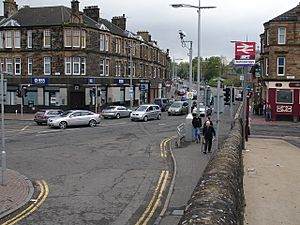
The town centre is known as 'The Village' or 'The Cross'. It has shopping areas like the Triangle Shopping Centre and Cross Court. The Triangle Shopping Centre was built where older buildings used to be. It now has shops and a large Morrisons supermarket.
There are plans to redevelop the Triangle Shopping Centre. This would include new shops, public spaces, and a bigger Morrisons. At Cross Court, you can find the war memorial, which was put up in 1920.
Other shops include an Asda superstore and the Strathkelvin Retail Park. This park has stores like B&Q and opened in 1992.
Bishopbriggs is also known for its beautiful Victorian villas (large houses). These were built after the railway arrived in the 1850s.
Education in Bishopbriggs
Bishopbriggs has six Primary schools: Balmuildy, Meadowburn, St Helen's, St Matthew's, Thomas Muir, and Wester Cleddens. Meadowburn Primary School also has a special unit for learning in Gaelic.
There are two secondary schools: Bishopbriggs Academy (non-religious) and Turnbull High School (Roman Catholic). Both schools are considered among the best in Scotland. Bishopbriggs Academy was even named Scottish State School of the year in 2014 and 2017. Both schools moved into new buildings in August 2009.
Bishopbriggs Academy was formed in 2006 by joining Bishopbriggs High School and Thomas Muir High School. The new building was planned for the old Bishopbriggs High School site. However, it was later moved to the former Thomas Muir High School site. This decision caused some debate at the time.
Healthcare Services
There have been some changes to local healthcare. The nearby Stobhill Hospital now focuses on day-care services. This means that the closest Accident and Emergency and overnight hospital stays are at the Glasgow Royal Infirmary in the city centre.
Religion in Bishopbriggs
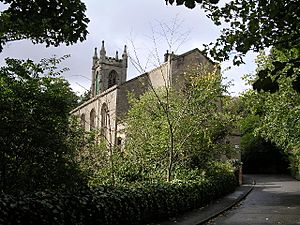
The Church of Scotland has three churches in Bishopbriggs: Cadder, Kenmure, and Springfield Cambridge. The Free Church of Scotland also has a church. The Scottish Episcopal Church of St James The Less moved to Bishopbriggs in 1980.
There are two Roman Catholic churches: St Matthew's (built in 1950) and St Dominic's (built in 1977). Bishopbriggs Community Church and Woodhill Evangelical Church also serve the town. There is also a Kingdom Hall of Jehovah's Witnesses.
Other Town Facilities
Bishopbriggs has a public library. It's in the old Bishopbriggs School building, which opened in 1896. The library was updated in 2003.
Many companies have offices or centres in Bishopbriggs. These include the publisher HarperCollins, an Aviva customer service centre, and the graphic design firm John McGavigan. Construction companies like Carillion and Robert McCarroll Plant Hire are also based here.
However, Bishopbriggs is still mainly a place where people live and travel to work in Glasgow. About 80% of its workers commute to the wider Glasgow area.
HMP Low Moss is located on the edge of town. It used to be a World War II Royal Air Force balloon station. In 2007, it was decided to make the prison much bigger to hold 700 inmates. The old prison closed in May 2007, and a new one is being built.
Getting Around Bishopbriggs
Glasgow International Airport is the closest major airport. Bishopbriggs is connected to the UK motorway system by the M80 motorway. The main road through Bishopbriggs is Kirkintilloch Road, which is part of the A803. This road connects Glasgow to Falkirk.
The town has its own train station, Bishopbriggs railway station. It's the first stop for local trains from Glasgow Queen Street station on the Croy Line. A train journey to Glasgow takes only 6 minutes.
The Bishopbriggs part of the Forth and Clyde Canal opened in 1775. This canal connected the River Clyde to the River Forth. It reopened in 2003 for boats as part of a big project.
Buses also provide services through the town. Companies like First Glasgow and Glasgow Citybus run routes connecting different parts of Bishopbriggs and nearby areas.
The Canal in Bishopbriggs
The Bishopbriggs section of the Forth and Clyde Canal opened in 1775. When it was finished, it connected the River Clyde at Bowling to the River Forth at Grangemouth. The canal reopened in 2003 for boats as part of the Millennium Project. This included rebuilding the Farm Bridge over the Canal at Mavis Valley.
Sports and Culture
Bishopbriggs has several sports facilities. The former playing fields of Allan Glen's School are used by Allan Glen's RFC, a rugby club with teams for all ages. There are also youth football teams like Rossvale.
The town has three golf courses. The oldest, Bishopbriggs Golf Club, started in 1906. Cawder Golf Club, established in 1933, uses Cawder House (built in 1654) as its clubhouse. Bishopbriggs also has two bowling clubs.
Cadder Curling Club meets at Braehead. The town has several youth groups like the Boys Brigade, Scout group, Girls Guides, and Girls Brigade.
Famous People from Bishopbriggs
Many well-known people have lived in Bishopbriggs. These include:
- The political reformer Thomas Muir of Huntershill.
- Actor and writer Dirk Bogarde.
- TV presenter Jenni Falconer.
- Singer Amy Macdonald.
- Former Miss Scotland and Miss United Kingdom Nieve Jennings.
- Actor and rock singer Steve Valentine.
- Footballer Stuart Bannigan.
- Poet laureate and novelist Professor Jackie Kay.
- Musicians Paul Buchanan and Paul Joseph Moore from The Blue Nile.
- Bassist Jack Bruce from the band Cream.
- STV presenter Storm Huntley.
- Humorists Sanjeev Kohli and his brother Hardeep Singh Kohli.
- Oscar-winning director and actor Peter Capaldi, who went to St Matthew's Primary school.
Sports stars include Alastair Kellock, a rugby player who captained Glasgow Warriors. Footballers James McFadden (who went to Turnbull High School) and Gerry Britton also lived here.
Twin Towns
Bishopbriggs is twinned with two other towns:
- Corbeil-Essonnes, France
- Yoichi, Japan
See also
 In Spanish: Bishopbriggs para niños
In Spanish: Bishopbriggs para niños


